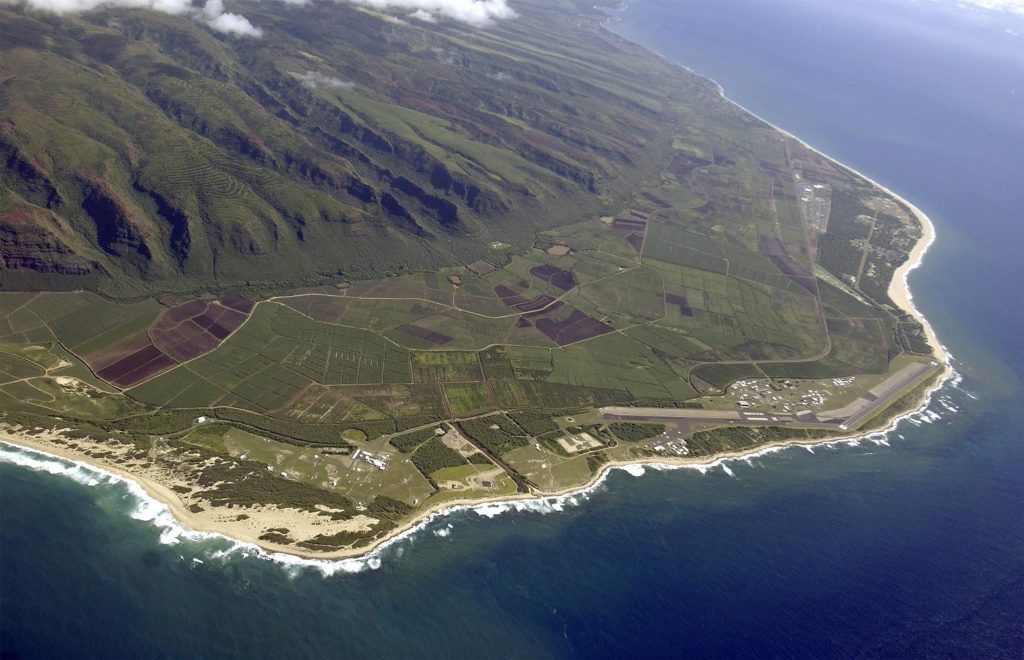Department of Defense Grant to Address Impacts of Sea-Level Rise to Mānā Plain

By Amanda Kurth
A $1.9 million grant through the Department of Defense was awarded to the Garden Island to allow for the development of 200 acres of Open Floodable Space of Mānā plain with the Pacific Missile Range Facility, also known as PMRF.
The land, owned by the state’s Agribusiness Development Corporation, or ADC, and managed by the Kekaha Agriculture Association in West Kaua’i, sits in the vicinity of the former Nohili loko pu’uone, land that is currently drained by a century-old ditch system.
The award was made by the Readiness and Environmental Protection Integration, or REPI program to mitigate flood impacts caused by sea-level rise to land near Pacific Missile Range Facility, also known as PMRF.
“When construction began on the agricultural drainage ditch system, more than a century ago, sea-level was 0.75 feet lower than at present, and by mid-century sea-level is projected to rise by another 2 feet,” KAA stated in a June 17 press release. “Agricultural land on the Mānā Plain will become more vulnerable to event-based flooding as sea-level continues to rise, because storm runoff will no longer always drain naturally into the ocean.”
Not only is it facing an increased risk of flooding as sea levels continue to rise but the land is also experiencing storm run-off from the adjacent uplands and the native bird populations striking military aircraft.
“Projected sea-level rise could impact PMRF from the mauka side of the installation if storm and surge events on the Mana plain are not effectively mitigated,” stated Tom Clements, PMRF spokesperson to Kaua’i Now. “PMRF is also an airfield, and we welcome efforts that humanely and effectively encourage bird populations to congregate away from our aircraft operations.”
The funding award was the result of joint effort with PMRF’s Environmental staff and KAA. A proposal was written for the nomination of the Readiness and Environmental Protection Integration, or REPI challenge.
The development and design phases of mitigation efforts, which will take two years, ending in 2025.
When funded, the construction phase will take an additional two years.
When Kaua’i Now asked what sort of resilience and preservation efforts will benefit both the base and its agri-neighbors, Clements noted the rural location of the land.
“PMRF is a test and training range and like other Department of Defense range installations, benefits from low population density activities near the base,” Clements said. “Agriculture is one of the best neighbors a range can have, so efforts to sustain or increase the viability of agriculture can also benefit the base.”
The natural infrastructure of the area outside PMRF will also help to retain the agricultural drainage ditch system’s hydrological functions.
Following up on an email exchange with Dr. Basil Gomez, whose nine-year consultancy work on the project helped to develop the low-tech and eco-friendly infrastructure, described to Kaua’i Now the future improvements on the nearshore environment at PMRF.
“…the installation of tide gates at the outlets as well as a regulating structure in the ditch system will be done by temporarily storing stormwater in flat areas (open flooding) and delaying peak flows at times when, as the sea level continues to rise, tide and wave height prevent runoff from being discharged directly into the ocean under the influence of gravity,” Gomez said.
Gomez, who is an adjunct professor at University of Hawaii at Mānoa, began engaging in studying the creation, transport, and dispersal of loose materials on the Earth’s surface in the late 1980s, forming his company KBAY Environmental Services LLC in 2009.
“This will improve the quality of storm runoff being directly discharged into the nearshore environment at PMRF and also create a flood-tolerant, multifunctional domain that will support and attract threatened and endangered Hawaiian waterbirds,” said Gomez, who also commented on the antiquated infrastructure.“
Now managed by KAA, the initial drainage ditch connection to the ocean at Kawai’ele was established in 1878 by Valdemar Knudsen’s Kekaha Sugar Company following the removal of the import tax on Hawaiian products in 1875,” adding, “The drainage ditches were initially dug to move surplus irrigation water and rainfall water away from the cane fields. By 1910, 7.5 miles of ditches had been excavated.”
In 1994, the Hawaii Legislature passed Act 264, which established ADC to facilitate and provide direction for the transition of Hawaii’s agriculture industry from the dominance of sugar and pineapple to one composed of a diversity of different crops.
ADC is attached to the Department of Agriculture for administrative purposes and is governed by a Board of Directors consisting of three ex-officio and eight private citizens appointed by the Governor.



